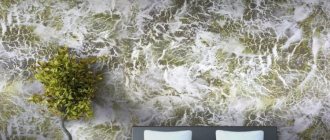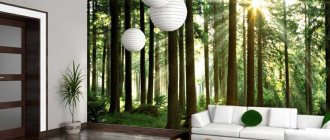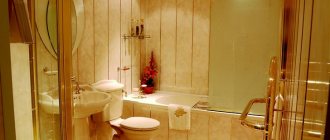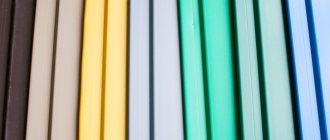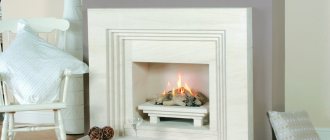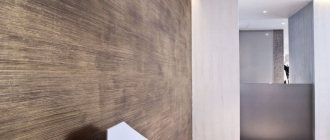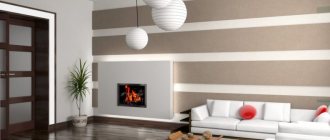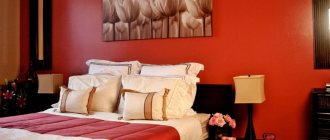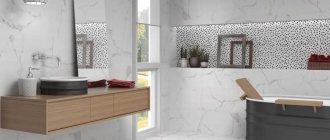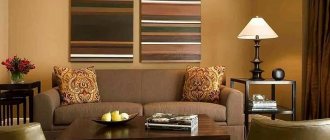The use of natural stone such as marble and granite creates a rich, monumental look for buildings that are distinguished by their durability and aesthetics. Using natural stone to decorate buildings is an expensive and time-consuming pleasure. Therefore, imitation of natural stone surfaces is now used, which is created using marble plaster.
Marble plaster in the living room of a country house
Decor of small tiles on Venetian marble plaster
Decorative marble plaster in an oriental interior
Marble-like decorative plaster - antique motifs in the interior (27 photos)
The construction market offers a wide range of materials for surface finishing.
They differ in scope, installation method, and price. The most popular materials that are rapidly gaining popularity include decorative marbled plaster. With its help, you can bring the most original and daring design solutions into reality, complement any interior, give it sophistication, elegance and charm. Marble plaster with painting in the living room White marble plaster on the wall of the living room Marble plaster on the columns in the corridor Marble plaster in a dark green shade
Once upon a time, marble was used to decorate walls in castles and palaces. Only very wealthy and respected people could afford such luxury. Thanks to modern technologies, you can make marble walls in any house or apartment. Decorative plaster is a reliable imitation of precious stone, presented in a wide range of colors, which allows you to choose an option for finishing almost any room.
Marble plaster on a bathroom wall Marble plaster in a country style house Red marble plaster on a column Marble plaster in the hallway of a private house
Design options in different rooms
Since there are different types of Venetian decorative plaster, you can choose the one that is suitable for finishing any room in the apartment. In order not to make a mistake, it is necessary to take into account the operational features of the option you like, especially when you plan to use the material to decorate a kitchen or bathroom.
In the kitchen
Increased demands are placed on premises in several directions at the same time. Therefore, kitchen decoration should be:
- moisture resistant;
- tolerates high temperatures well;
- emphasizes the comfort of the room.
Venetian plaster can be used in the kitchen - in the dining area, as there are types with good strength, moisture resistance and aesthetics. It is better to choose the option with a finishing wax layer.
Embossing the coating is not worth it, since cooking is always accompanied by the appearance of persistent dirt, even in the dining area. This will make the smooth surface easier to clean without damaging it.
It is not worth finishing a kitchen apron with Venetian plaster, despite all its features. She, of course, will have several intensive cleanings, but then she still needs to be restored.
On a note! If you have a strong desire to make a kitchen splashback from Venetian plaster, you should cover it with transparent glass panels. This way the appearance will be presentable, and the coating will not suffer from intensive cleaning.
In the bedroom
For this room it is better to choose Venetian plaster that imitates fabric. The finished upholstery looks like velvet, jacquard or silk, depending on the composition used. If you add pearlescent or metallic pigments to the plaster, a radiant effect will appear.
On a note! If the bedroom is decorated in a loft style or similar, you should use options for matte granite or marble. It fits well with general controls and panels.
In the living room
In this room, in fact, there are no restrictions on the choice of the type of Venetian plaster for wall decoration. You can use both smooth, rough or embossed solutions.
In addition, there are no special requirements for the characteristics of the finishing material, since in the living room, as a rule, there are no temperature changes, high humidity or the need for regular intensive cleaning. Otherwise, you should be guided by the general style of the room.
In the hall
The main requirements for finishing materials in the hallway and corridors are strength and durability. Since there is rarely a window in this room, in fact, sunlight does not penetrate there or penetrates in minimal amounts, you don’t have to worry about color fading. But you need to think about the fact that the corridor is a transit room, so it is better to make the finishing even. This will make cleaning easier.
As for the color of the hallway and hallway decoration, the recommendations are general: for a small room it is better to choose light colors, and for spacious ones, light, dark, and light colors are suitable. The main thing is that the space looks harmonious.
In the bathroom
It used to be that Venetian was an impractical option for finishing a bathroom. But now, when new waterproof types have appeared, the situation has changed dramatically.
Venetian plaster for the bathroom is used quite actively, as it allows you to make the design unique and original. The main thing is to choose the right color for the finish. So, for small bathrooms it is better to use light shades. But for spacious bathrooms, any option is suitable; here you need to focus on the overall style.
But you need to remember the requirements for finishing materials in the bathroom. So it should be:
- lasting;
- moisture resistant;
- Don't be afraid of sudden temperature changes.
To facilitate maintenance, it is worth covering the Venetian plaster with a layer of colorless varnish, special wax or enamel. This will also improve its performance and extend its service life.
Attention! When finishing a bathroom, Venetian plaster should be smooth. If the surface is embossed or even slightly rough, there will be problems with cleaning it, especially in hard-to-reach places. Therefore, if moisture accumulates in the uneven surfaces, this choice may cause mold to develop.
Children's room
A self-confident and harmless Venetian will help decorate a child’s room in both bright, saturated colors and calm, gentle colors. The plaster mixture is considered a self-sufficient finishing element, which significantly transforms the room and makes it much more effective.
Balcony
Such a durable and practical design will add incredible expressiveness and volume to the balcony space. A variety of colors and natural patterns will create an unusual play of light in this room.
Advantages of marble plaster
Decorative marble plaster is a mixture, the main component of which is marble chips. A unique composition containing preservatives, antiseptic, and moisture-repellent substances, as well as a special application technology, makes it possible to create a coating that most accurately reflects the surface of the precious stone. This material has many advantages.
There are several types of finishing materials that can be used to successfully imitate a marble surface. The most practical and reliable is marble-granite plaster, which is characterized by the best performance qualities and can be used in commercial premises. The composition with granite grains is very durable and adheres well to the base. But most often they use a material with marble chips, with which you can accurately display the stone surface on the walls of a private house or apartment.
Venetian marble plaster Black Venetian marble plaster in the bathroom Marble plaster on the wall of the living room in the Art Nouveau style Purple marble plaster in the Art Nouveau style
The disadvantages of decorative marble plasters include their high cost. However, the price is completely justified. This repairable, aesthetic and reliable coating will last for many years. Do not try to save money by purchasing low-quality material; this will certainly affect both the aesthetic and performance properties of the finished surfaces.
Marble plaster with green veins on the kitchen wall Marble plaster on the wall in the hallway of a private house Marble plaster with a pattern in ethno style
Advantages and disadvantages
Advantages:
- High level of strength and resistance to mechanical stress. This increases the service life of the plastered surface. A composition that contains a small amount of granite chips is more durable.
- Many shades, the ability to combine different colors.
- Good vapor permeability. Condensation does not linger in the walls; they can “breathe.”
- Environmental friendliness. Marble is a natural material that does not poison the human body or the environment.
- Resistance to UV rays, rain, wind, snow. The previously specified shade lasts for 13–16 years.
- Suitable for finishing interior spaces and facades, regardless of the surface material.
- Easy care and cleaning. If a protective layer is applied, you don’t have to worry about its rapid contamination or damage.
- Effortless dismantling. Easy to remove if you decide to change the interior.
- The formation and reproduction of fungus, mold, and pathogens is excluded.
- Price-quality ratio".
Disadvantages of marble finishing:
- Rapid curing of the composition. If you do not use the prepared solution within 40–45 minutes, it will deteriorate and become unusable.
- Application technology. Requires the use of many tools, skills, patience and accuracy. If you do not have minimal experience working with plaster mixtures, seek help from professionals.
- Chemical intolerance. Especially the effects of hydrochloric acid. Therefore, it is not recommended to use aggressive cleaning agents.
- High price.
Scope of application
Decorative plaster imitating marble can be used to finish surfaces in different rooms. It looks impressive in the bedroom and living room, hallway and nursery. This is a functional and practical option for finishing walls and ceilings in the kitchen and bathroom, because the material is not afraid of high humidity, water, temperature changes, and is resistant to damage. Exquisite imitation marble will add grandeur and special charm to any room.
As for style trends, marble plaster is almost universal. For rooms with characteristic features of classical styles (Baroque, Italian, Provence), mixtures of light shades are used: white, beige, milky. If the interior is modern (loft, minimalism, country), neutral and dark tones will fit perfectly into it.
Decorative plaster fits perfectly on various materials, as it has a high degree of adhesion. It is easy to work with it when finishing plasterboard, reinforced concrete slabs, bricks, foam blocks, and chipboard panels. Excellent moisture resistance, wear resistance and aesthetics allow the use of decorative plaster not only for interior but also for exterior decoration. Marble-clad columns and other complex architectural elements look beautiful.
Marble plaster on the wall of a staircase in a private house Purple marble plaster Marble plaster using a minimalist application technique in the living room I will go out into the field at night sheet music for piano
Features of finishing from a historical perspective
The design method comes from Ancient Rome. It was there that they first thought of combining marble flakes with slaked lime. The solution was applied to the wall and as a result acquired a luxurious look. Visually, the surface was mistaken for a slab of natural marble, but without seams.
Natural dyes were added to highlight the pattern more clearly. In those days they settled on clay. The resulting reddish stripes further emphasized the appearance of the marble. Little has changed in the recipe over the centuries. All natural ingredients are also used, which are sometimes replaced with modern synthetic ingredients.
Venetian plaster includes:
- Marble chips. Sometimes it is replaced with granite or quartz. The quality of the solution is determined by the proportion of raw materials. The smaller it is, the more flexible the composition.
- In modern Venetian plaster, slaked lime is often replaced with polymer components.
- The dye is used both natural and its synthetic analogue.
- The emulsion is taken in water or latex. Sometimes these two components are mixed.
- Artificial or natural additives. The most commonly used material is plaster.
But the main feature of the finish is wax, which gives the wall a glossy look and protects it from moisture. At the final stage, it is rubbed into the surface. Thanks to this operation, the walls acquire unique beauty and depth. It also depends on the wax: whether the surface will shine or remain opaque.
The method was especially popular in Venice. During the Renaissance. The decoration began to be used to decorate the columns of palaces. And also the walls and ceiling. Visually, the surface looked like the most natural marble. And it’s easier to work with mortar than with stoves.
Architects of that time appreciated the resistance of the treated surface to high humidity and frequent temperature changes. In fact, with multiple water channels, any other finish proved to be short-lived. The secret of wall treatment is spread all over the world and is called Venetian plaster. Because the method has achieved the highest recognition in this field.
Application technology
The marble surface is well polished, smooth and even. To achieve the same effect using decorative plaster, you should follow the recommendations of specialists when performing work. It is very important to choose quality material. You should not feast on low prices, because often they hide not very good quality. When purchasing a mixture, you should pay attention to the manufacturer and composition. Decorative plasters from Italian manufacturers are considered the best.
In order for the finishing material to adhere well to the surface and hide all defects, it is necessary to carefully prepare the base.
The ceiling or wall is cleaned of the old coating and sanded. If there are weak spots, they should be tapped with a hammer so that the old plaster falls off before you start working with finishing materials. Next, you need to seal all the cracks and level out the unevenness. Then the base is treated with a primer. Working with marbled decorative plaster consists of several stages.
If everything is done correctly, you should end up with a beautiful, durable coating that resembles a marble slab. Since the material is not cheap, do not undertake finishing work yourself if you are not confident in your abilities. It is better to entrust this matter to professionals. Walls and ceilings finished with decorative marble plaster will retain their original qualities throughout the entire operational period, delighting with their attractive appearance.
Gray marble plaster in a bathroom Marble plaster on columns in a bathroom Gray marble plaster on a ceiling structure
Source
What color is the Venetian?
The most popular colors.
White
It allows you to advantageously enhance, highlight and emphasize other shades and decorative elements in the interior. Use white, grey-white or ivory to create a perfect and fresh design.
The photo shows a wall finished with white and gray Venetian plaster.
Blue
It will bring special sophistication and sophistication to the atmosphere and create a relaxing and calm interior.
Grey
The elegant and unique shade of gray is very practical. Undoubtedly, this will add some aristocracy to the room.
Black
Create rich, bold and contrasting accents in your interior. A room decorated in black will look modern and noble and will take on a more expressive and clear look.
Green
It evokes heat, summer and fresh herbs. This color creates a comfortable environment and makes it interesting, unusual and very colorful.
Turquoise
It has special brightness and saturation. Turquoise color radically transforms the room and, undoubtedly, becomes its main accent.
Beige
Classic light beige shades in the interior look restrained, calm and elegant. Thanks to their neutrality, it is possible to create a discreet design and visually expand the space.
Blue
Incredibly delicate and sophisticated blue color creates a soulful and soft atmosphere.
The photo shows a children's room and walls lined with blue Venetian mother of pearl.
Silver
Fills the room with mysteries and moonlight. Silver tones, thanks to their alluring iridescence, create bold sparkling accents in the room.
Marble plaster - a noble texture in the house (25 photos)
The use of natural stone such as marble and granite creates a rich, monumental look for buildings that are distinguished by their durability and aesthetics. Using natural stone to decorate buildings is an expensive and time-consuming pleasure. Therefore, imitation of natural stone surfaces is now used, which is created using marble plaster.
Marble plaster in the living room of a country house Decor of small tiles on Venetian marble plaster Decorative marble plaster in an oriental interior
Rules of care
Interiors with marble floors and walls made of this stone have a very impressive appearance, to maintain which you must adhere to certain rules:
- do not use acid-containing household chemicals when cleaning a living room with a marble floor;
- abrasive powders and cleaning creams are prohibited;
- immediately remove stains from spilled liquid, otherwise the floors will quickly lose their presentability;
- white marble stone can be damaged by excessive ultraviolet radiation, so it is recommended to create twilight in the room;
- traces of fat are neutralized with ordinary alcohol;
- Rust can be removed only with professional products.
ADVICE. The cladding will be bright and expressive if it is treated in time with special wax polishes. Clean yellowed areas with a mild soap solution or a drop of hydrogen peroxide. Follow these instructions to ensure the surface remains as neat as the day it was installed.
What is marble plaster and its properties
Decorative marble plaster gets its name from its filler of crumbs made from marble and its dust, combined with lime flour. Also includes:
Thanks to this composition, the coating based on marble chips gives the surface a unique texture and is used as a finishing touch. This material has excellent adhesive properties and bonds well to brick, concrete, plasterboard and other surfaces. Decorative plaster “marble chips” does not require labor-intensive work and can be used for finishing the walls of the kitchen, bathroom and other rooms inside the building, as well as for cladding the external sides of buildings. This finish gives the surface the following properties:
Features of the material
This type of building material may have different composition. Its features depend on the components of which it consists. The basis is marble flour or crumbs. Often, to reduce the price of this material and increase strength, manufacturers can add fine granite.
They are combined into a single mass using mineral additives or acrylic resins. It is possible to add special compounds to combat mold, fungi and pathogenic bacteria. Natural mother-of-pearl is often added for beauty.
Advantages and disadvantages
Marble plasters have many advantages:
- suitable for finishing work not only inside the house, but also for exterior finishing of facades and other surfaces;
- long useful life;
- color is not limited to the natural palette of marble;
- successfully resists mechanical stress;
- breathes;
- not afraid of moisture, temperature swings and ultraviolet radiation;
- effectively protects surfaces from mold and mildew;
- absolutely safe from an environmental point of view;
- It is comfortable to work with this type of plasters.
Flaws:
- over time, the original color saturation of the coating loses;
- may collapse upon contact with a number of chemically aggressive substances (hydrochloric acid, etc.);
- this pleasure is not cheap.
Types of marble plaster
Finishing materials based on marble chips are divided depending on the size of the filler fraction. The grains of crushed marble should be approximately the same size, so the crumbs are pre-calibrated. This is necessary to ensure that the surface covered with crumbs has the same thickness and is even.
Marble plaster in the interior of a country house Marble plaster in the interior of a bathroom Marble plaster in the decor of the living room of a private house
There is the following division of plaster according to grain size:
The purpose of the marble coating depends on the size of the grain fraction. For interior finishing, fine-grained material is used, and for decorative coating of facades, medium-grained and coarse-grained compositions are used.
Cement-based marble plaster Marble plaster with an antique effect in Provence style Marble plaster with a craquelure effect in a Provence interior
Plaster with marble chips is also classified according to color. If previously only chips were used, which had natural shades, often heterogeneous in color, now many tint colors are used, which give the filler a shade of a natural character or a color different from natural marble. For this purpose, light-resistant pigment dyes are used that do not fade from sunlight and retain the original color for 15 to 25 years of operation of the coating.
The use of tint colors allows you to create a wide variety of finishes with this material.
There are also different types of marble mixtures, the composition of which differs not only in the grain fraction and its shade, but also in the composition of the filler used. Such materials include granite-marble plaster, Venetian and mosaic varieties.
Marble plaster with a rust effect in the living room Wall decor with marble chips Gray marble plaster
The filler of the granite-marble mixture includes, in addition to marble chips, a granite fraction. This significantly affects the strength characteristics of the coating, making it resistant to mechanical damage. However, the addition of granite chips to the mixture also affects the degree of adhesion to the polymer binder component; it becomes lower.
Bork air humidifier and purifier for apartments
Marble plaster in apartment decor Marble plaster in an aged chic interior
Facade marble plaster is most often granite-marble due to its high mechanical resistance. It is also used for finishing the outer surfaces of plinths and arched structures. In this case, it is more economical to choose materials in which the binder component is white cement M500.
Marble Venetian plaster as a filler includes a dust fraction from marble with the addition of granite, quartz, malachite or other stones. The quantitative ratio of the mixture components significantly affects the quality characteristics of the coating and its decorative appearance. The finer the components are ground, the smoother the pattern and the smoother the surface.
Until some time, the binding agent of the Venetian variety of material was slaked lime. With modern production technologies, acrylic resins are more often used as a binding element. Pigment of both organic and inorganic origin is also added.
Marble plaster in bedroom decor
There are several types of Venetian plaster mixture based on composition and density. The higher the density, which is manifested by its adhesiveness in the finished form, the smoother and better the coating is. The surface on which this material is applied must be carefully leveled to a smooth state, otherwise the marble dust will reveal all problem areas with bright reflections when the composition dries.
Venetian plaster mixture is mainly used to decorate surfaces in an antique style.
Mosaic marble plaster is a material whose filler is a mixture of chips of different colors from marble, granite, quartz, malachite, lapis lazuli. Using stones of different colors, a unique mosaic look is obtained. Crumbs of one of these components, painted in a different color from the natural shade fractions, can also be used. The colored filler is connected using glue based on an acrylic component.
Marble texture plaster in the bathroom
Using mosaics, you can create pictures in the form of panels on the wall. The mosaic variety is often used for the decorative design of individual interior fragments of niches, columns, and arched structures.
Composition of marble mixture
Plastering brick walls outside
In everyday life, marble decorative plaster is often called bayramiks - in honor of the Turkish construction company that laid the foundation for this technology. If you see reviews about Bayramix plaster on a construction forum, you already know what material we are talking about.
The base of the marble mixture differs from the bases for traditional mixtures in that it is transparent, in most cases acrylic. In terms of physical properties, it is a polymer adhesive that firmly attaches fairly heavy mineral chips to any surface, as long as this surface is properly primed.
In some ways, marble chip plaster is similar in composition to Venetian plaster, which also has a transparent base. But Venetian plaster is based on a much more complex application technology, up to a dozen or more layers. And even a non-professional can work with marble chips, and judging by numerous reviews, with successful results.
The color of fillers for this mixture varies. For facades, a mixed granite-marble filler of increased strength is produced.
Initially, unpainted marble granules were added to the plaster, so the color of the working mixture varied greatly even within the same batch, since the layers of natural marble are different in color. Modern technologies make it possible to paint stone chips in various colors with dyes that are resistant to moisture and sunlight. The main range is natural shades, there are more than three hundred of them. But you can find marble plaster of very exotic colors. Such brightly colored mixtures are used to create interiors, in particular, in ethnic style - photo.
The size of filler granules varies widely, but in high-quality mixtures the mineral grains are always carefully calibrated and regulated by the following standards:
Grain size, mm.
The granules can be either simply crushed or ground to a spherical shape: photo.
Technology of applying marble mixture
The peculiarity of preparing the surface for this coating is as follows - since the plaster is transparent, it is necessary to even out the color of the base. This is done at the priming stage. Two types of primer are applied - one to increase adhesion to the surface, the second - most often tinted to match the color of the mixture. After applying each coat of primer, wait 24 to 48 hours, depending on the air temperature.
In accordance with the instructions, it is optimal to carry out work at a temperature of about +20C and normal humidity of 75%. However, experience shows that marble plaster can be applied outdoors at temperatures from +5C, in dry weather, with successful results.
The classic method of marble plastering is no different from the methods of working with most other mixtures. Tools from the usual plasterer's set are used:
- container for mixing the solution (you can mix it directly in the bucket);
- drill with a mixer attachment set to low speed;
- stainless steel spatula about 35 cm long;
- stainless steel grater-stroker;
- flat brush;
- tape measure, masking tape;
- protective equipment, stepladder, etc.
If necessary, if it is discovered that the freshly opened plaster has become too thick, it can be diluted with plain water to the consistency of sour cream.
The mixture is applied to a dry prepared surface and stretched from bottom to top. In this case, the thickness of the layer of marble mixture should not exceed one and a half grains of filler. Excess mortar is removed from the spatula with a trowel and sent back to the bucket with the mortar. The mixture must be stirred from time to time, as the mineral settles to the bottom.
The peculiarity of acrylic plasters, including this one, is that they dry very quickly. Therefore, most often marble finishing work is carried out by a team of two people: one applies and levels the mixture, and the other then polishes the surface. When polishing, it is recommended to frequently dip the grater in a bucket of water and press firmly, then the mirror shine characteristic of marble will appear.
When working with finely granulated marble plaster, it is effective to use a crusher compressor, otherwise known as a hopper. To see how much more productive this method is than manual work, take a look.
All about plaster and putty
Technology of using marble plaster
The quality of finishing and appearance of the surface covered with marble plaster depends on compliance with the technology of its use. In this case, the order of performing the following operations must be observed:
Let's look at how these stages of work are carried out.
Surface preparation
Any surface on which the decorating layer will be applied must be cleaned of dirt and greasy stains. Saw off or knock down with a hammer all protruding parts. Cover cracks and dents with a compound that has good adhesion to the base. In case of large unevenness, it is necessary to lay a reinforcing mesh. After applying the rough putty, the base should be sanded.
Marble Venetian plaster with mother of pearl
For coarse-grained marble plaster applied to the facade, minor cracks and defects are allowed, since they can be easily closed with a thick decorative layer. A perfectly smooth surface is required only when applying the Venetian mixture.
Applying primer
The primer of the leveled layer is necessary to improve the adhesion of the decorative material to the base in order to prevent the plaster from peeling off after drying. Before applying the primer, you need to check how well it will be absorbed by the surface layer. The marble coating will adhere firmly to the wall once the water from the solution has completely evaporated. If the walls are not coated with a primer beforehand, the water from the plaster mixture will be absorbed into their surface layer, which will lead to poor adhesion.
The primer can be abandoned only if the wall is covered with a material that practically does not absorb moisture. This can be checked by applying a test primer. If a shiny film forms after a few hours after it dries, then the step of priming the base can be abandoned.
Venetian plaster in the living room
In this case, it is better to sand the glossy base in order to roughen the surface layer of the base for better adhesion of the decorative plaster to it.
Decorating with a marble layer
Marble plaster is applied to the base using a spatula, the size of which is 30 cm or more. A larger size is used when working with large façade areas.
After applying to the wall, a portion of the mixture is evenly spread on it with sufficient force to ensure good adhesion to the base. It is important to finish finishing one wall without stopping, without waiting for it to dry. Then the joints of the extended sections will not be visible.
Venetian marble plaster with “space effect”
To ensure a uniform shade of plaster in the interior, it is recommended to apply a color paint on the base that is close in shade to the color of the marble chips. Then the clearings of the dark and light background will not be visible. It is better to purchase material of the same shade at the same time in one place. This will also save on marble plaster. The use of painting the base when finishing with Venetian plaster is especially important. Otherwise, you will have to cover the surface with several layers of plaster.
act of acceptance of transfer of dacha and land plot
Source
Rules for preparing the surface for applying the finished mixture
Preparing the base for applying marble plaster is an important element in the technological chain. First, the surface is leveled, then excess dust is removed from it, covered with primer, and only after it has completely dried, marble plaster is applied. To improve the performance characteristics of the mixture, antibactericidal components are additionally introduced into it, increasing adhesive properties and increasing plasticity. Special chemicals introduced into the plaster mixture increase the resistance of the finished surface to the negative effects of ultraviolet rays and mechanical stress. Ready-made marble plaster is resistant to aggressive chemicals: acids, alkalis.
To achieve an additional decorative effect, mother-of-pearl or glitter is added to the plaster mixture. If desired, you can also coat the finished surface with varnish or wax.
Marble plaster wall decoration with decorative chips - 25 photo ideas
Marble plaster is a universal way to hide flaws and imperfections in walls, giving them an excellent appearance. This method has been relevant since Antiquity! There are different types of plaster. The only thing that is different now is that everyone who wants to learn can make decorative plaster with marble chips, and not just a select few, as was the case in those centuries.
Adviсe
In order for marble plaster to adhere well and the finish to be durable and beautiful, you should follow several rules during the work.
- All work must be carried out in dry, but not hot weather. It is undesirable for the sun's rays to fall on a freshly treated surface.
- Lamps, if there are any on the walls, should not be turned on until the plaster is completely dry.
- The thickness of the plaster layer should not be more than twice the size of one filler crumb.
- Plaster should be applied to one wall continuously to avoid the appearance of unevenness.
- If it is cool outside, then the plaster should be given at least two days to dry completely.
- The drawing is best applied using patterns.
- If coarse marble plaster is used, it can also be applied to rough plaster. But the fine-grained one should be applied to clean putty or a sanded smooth surface.
Marble plaster is a universal method that allows you to hide imperfections in the walls of a building and give them a presentable look.
Prices for different types of plaster floats
Plaster grater
Decorative marble plaster
Based on the name of the material, it becomes clear that its main component is marble chips. Various components can be added to the mixture. It all depends on what tasks and goals you have in front of you.
Even the Ancient Egyptians used this amazing material; looking now at the photo of marble plaster produced then, we can talk about the highest strength of the material. In addition, the solutions offered in our time are much more decorative, since pigments can be selected in different tones, and the composition can be applied in any shape, even if you have no skills at all to work with it.
DIY marble plaster mortar
If desired, you can make a dry mixture of marble decorative plaster at home, and then a solution for application to the prepared surface.
To create the composition you will need:
- cement grade M500 and higher - 1 part;
- slaked lime - 1 part;
- marble chips of the required fraction - 3 parts.
All dry ingredients should be placed in a large container and mixed thoroughly. If necessary, you can immediately add dry color to the composition. If you are preparing marble plaster for the facade, you can increase the amount of cement by 1 part. This will increase the adhesion strength of the material to the surface.
Types of marble plasters
In general, this material is divided into those made from marble chips and those made from flour. In the first case, the plaster can be very fine, or vice versa. In both types, there are differences in colors and components included in their composition.
Granules can be faceted, spherical in shape. Colors can be natural, which depend on the color of the stone, or colored, obtained by adding pigments to them.
What the consumption per square meter will be depends on the size of the material fractions, for example, if from 0.5 to 1 mm, then the consumption will be from a kilogram to two and a half. If the size is 1-2 mm, you will need two or even three kg, with 2-3 mm, four to five kg, etc.
Cooking proportions
Each manufacturer himself indicates the proportions and algorithm for preparing the plaster mortar on the back of the package, often step by step. You can try to prepare it yourself, but it is better to prefer a factory-made mixture to get a guaranteed result.
Approximate consumption
Structural plasters made from marble chips are applied in a layer of 1 to 3 millimeters. It all depends on how deep the texture you want to achieve. If you plan to apply one time to a height of 1 mm, then 1 kilogram of plaster mixture will be required per 1 square meter of surface. 10 square meters of wall in the same one layer - a 25 kg bag of the mixture will be enough. If you want to apply in 2 to obtain a thicker coating, it is better to purchase two bags in advance.
Tool for applying plaster with marble chips
In large rooms, plaster is best applied mechanically, using a hopper. If the rooms are small, use a trowel. For the first case, you will need at least two people.
What tools should you use? A bunch of! For example: a container for mixing the solution; electric drill to stir the mixture; Master OK; trowel; putty knife; flat brush; roller for priming; roulette; ladder. In addition, you should prepare paint, an extension cord, oilcloth and protective equipment.
Required Tools
When applying marble plaster, in addition to the mixture itself, you will need a certain set of tools, including:
- Two types of spatulas: wide and narrow. It is recommended to purchase one rubber and the second made of stainless steel.
- Grater, grater.
- Trowel.
- A set of sanding paper: for working by hand and for use with a sanding machine.
- Plastic container for mixing components.
- Electric drill and mixer attachment. It is needed to work with dry mixture.
- Stepladder.
- Building level or plumb line.
- Master OK.
In addition, Primer and putty.
Also, when processing a large area, you will need a machine to apply ready-made marble mortar.
Do not forget!
It is necessary to work in special clothing, using personal protective equipment. When working indoors, you can do without outside help. When processing the facade, it is better to use a couple of assistants.
Preparing the walls
There are also temperature restrictions. You can plaster from five to thirty degrees Celsius. If finishing work is carried out outside the premises, do not expose it to the baking sun or precipitation.
Application of marble plaster
What layer is applied to the walls depends on the size of the marble chips. Scoop up a little solution with a spatula and spread it along the edge of the trowel, applying a thin layer to the wall in a chaotic mosaic. Try to do the work quickly so that you can complete the wall at once, otherwise the joints will be visible. But right away, you can’t level the surface, otherwise what you applied may come off. Therefore, immediately after applying the material, it should be leveled. Well, if you have an assistant, then you apply, he follows you and levels the surface.
The plaster should be leveled using a steel float, which is pre-moistened in water. After completely covering the room with plaster, you need to let it dry very well, and only then apply varnish. The ideal period for all this is about six weeks.
Finish coating
It is best to further protect the plaster layer after complete drying. For example, you can varnish, but only after the layer has dried for 24 hours.
You will need to first sand the surface and apply paint in order to highlight the beauty of the texture.
Then apply varnish, preferably water-based, and let it dry completely. This varnish dries quickly and spreads better over the surface of the plastered wall. The paints used are the same as for interior and facade work, taking into account the specifics of use.
Wax will also help refresh faded paints and highlight the texture. It will also protect against dust, dirt and mechanical damage.
Advantages of decorating walls with marble chips
This material is not afraid of fungus and moisture. Literally, after a couple of months, it will be very strong, so much so that even with a hammer it will be very difficult to knock it down. This means that the material is completely resistant to mechanical damage. Despite the low cost of the material, it pays off with longevity of use, because it lasts for more than one century!
Such surfaces are very beautiful and original, dirt is not too noticeable on them, and they do not require any special care.
Source
Preparatory stage
Preparation includes cleaning the walls from dust and dirt. We work with a brush and carefully inspect the surface. Having discovered crumbling areas and defects, it is necessary to clean them to the ground. We work with a metal brush. You can use a grinder with an attachment.
Do not forget!
Clean masonry joints thoroughly. It is in these places that voids form.
If there is fungus and/or mold on the surface, it must be removed and the affected area thoroughly cleaned. Be sure to treat with a chlorine-containing or antiseptic composition. Efflorescence is treated with a special cleaner, which can be purchased at a hardware store.
To get rid of chips and protruding parts, use cement mortar in a ratio of ¾: cement - sand.
Advice!
To properly prepare the walls, it is better to widen the cracks before sealing. Again, remove dust and clean up dirt. Remember to use fiberglass reinforcement tape.
We work by rule or level: we check the plane of the working surface. If necessary, problem areas are leveled with plaster. After application, the plaster must dry. Only then treat with primer.
